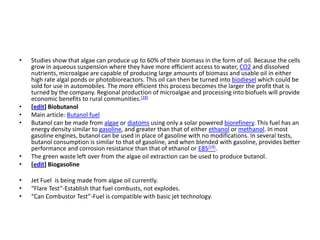Algae-based biofuels company that provides equipment and services for algae production and processing. They aim to become the premier algae solutions provider in Florida through projects like utilizing farmland for algae-to-biodiesel production. Algae oil has potential as a sustainable feedstock due to its high yields per acre and ability to grow anywhere. The company explores using algae for wastewater treatment and CO2 sequestration in addition to biofuel production.


































![Fuels Derived From AlgaeFuelsThe vegoil algae product can then be harvested and converted into biodiesel; the algae’s carbohydrate content can be fermented into bioethanol and biobutanol.[edit] BiodieselCurrently most research into efficient algal-oil production is being done in the private sector, but predictions from small scale production experiments bear out that using algae to produce biodiesel may be the only viable method by which to produce enough automotive fuel to replace current world diesel usage.Microalgae have much faster growth-rates than terrestrial crops. The per unit area yield of oil from algae is estimated to be from between 2,000 to 20,000 gallons per acre, per year(4.6 to 18.4 l/m2 per year); this is 7 to 30 times greater than the next best crop, Chinese tallow (699 gallons).](https://image.slidesharecdn.com/algaebasedbiofuels-090708180630-phpapp01/85/Algae-Based-Biofuels-35-320.jpg)
![Studies show that algae can produce up to 60% of their biomass in the form of oil. Because the cells grow in aqueous suspension where they have more efficient access to water, CO2 and dissolved nutrients, microalgae are capable of producing large amounts of biomass and usable oil in either high rate algal ponds or photobioreactors. This oil can then be turned into biodiesel which could be sold for use in automobiles. The more efficient this process becomes the larger the profit that is turned by the company. Regional production of microalgae and processing into biofuels will provide economic benefits to rural communities.[18][edit] BiobutanolMain article: Butanol fuelButanol can be made from algae or diatoms using only a solar powered biorefinery. This fuel has an energy density similar to gasoline, and greater than that of either ethanol or methanol. In most gasoline engines, butanol can be used in place of gasoline with no modifications. In several tests, butanol consumption is similar to that of gasoline, and when blended with gasoline, provides better performance and corrosion resistance than that of ethanol or E85[19].The green waste left over from the algae oil extraction can be used to produce butanol.[edit] BiogasolineJet Fuel is being made from algae oil currently. “Flare Test”-Establish that fuel combusts, not explodes.“Can Combustor Test”-Fuel is compatible with basic jet technology.](https://image.slidesharecdn.com/algaebasedbiofuels-090708180630-phpapp01/85/Algae-Based-Biofuels-36-320.jpg)




